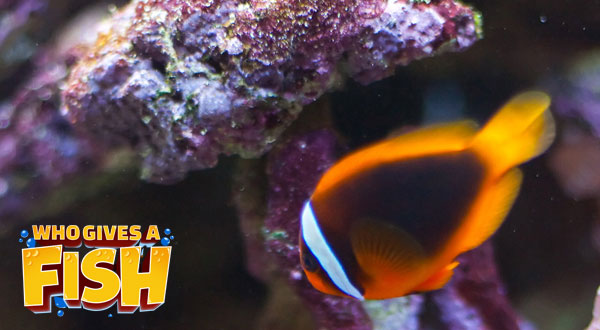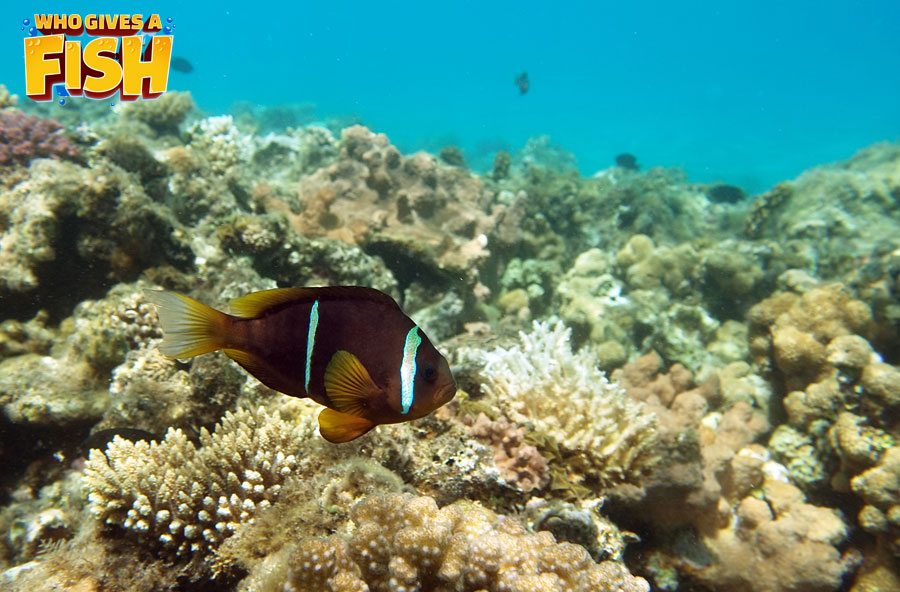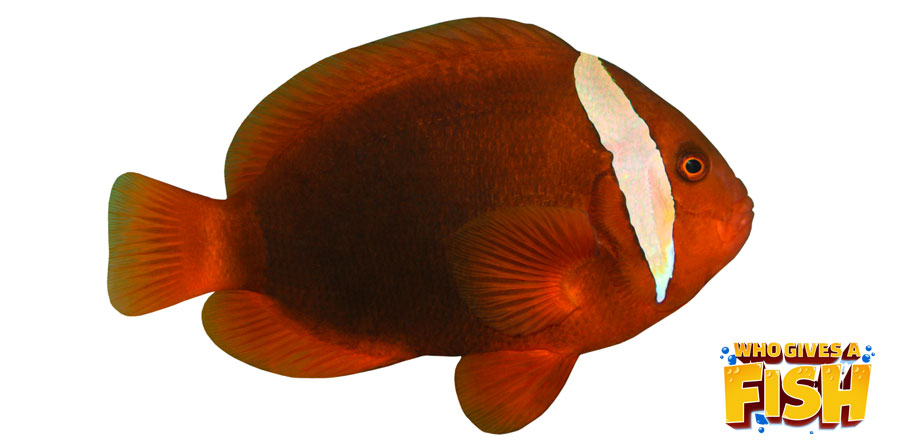Cinnamon Clownfish
The mature Cinnamon Clownfish, Amphiprion melanopus, looks as though it has been dipped in spice. A majority will be dull reddish brown or red with black on the anal and pelvic fins and body. The pectoral and dorsal fins are a reddish orange color and the tailfin is yellow. They will have either a white of blue headbar. Juveniles are a scorched orange color all over, with three bars, but two of them will wane as they grow older.
- Experience Level: Beginner
- Hardiness: Very Hardy
- Minimum Tank Size: 30 gal (114 L)
- Size of fish: 4.7 inches (11.99 cm)
- Temperament: Semi-aggressive
- Temperature: 72.0 to 82.0° F (22.2 to 27.8° C)
- pH Range: 7.8-8.4
- Diet: Omnivore
Table of Contents
Introduction
Aquarium Setup
Difficulty
Feeding
Breeding and Social
There are some variations in adult coloration depending on the locations where they originate from. These particular individuals range between a reddish orange color all over with no black on the body to just having a black spot. A few are also known to have red anal and pelvic fins, and the bar on the head could possibly be missing. These color forms are rarer in the hobby, and still with all this variance, this species has been labelled with various common names. These include the Melanopus Anemonefish, Dusky Anemonefish, Fire clownfish, Red and Black Anemonefish, Black Anemonefish and the Blackback Anemonefish.
The Cinnamon Clownfish pertains to a bunch of anemonefish referred to as the Tomato Complex. Its close relation to the Tomato Clownfish Amphiprion frenatus and is a famous part of this group. In contrast, the Cinnamon Clownfish are not as vibrantly colored, nor are they as large. Female Tomato Clowns are known to reach up to 5 1/2″ (14 cm) in length whereas a Cinnamon female will only grow to around 4.7″, and males are around .4 to .8″ (1-2 cm) smaller.
These particular anemonefish are also around an inch smaller than a majority of the Clarkii Complex clownfish. However, like the Clarkii anemonefish, they are also are notorious for wandering away from their host anemone.
When in the wild, their favored anemone host is the colonial type of Bubble Tip Anemone, Entacmaea quadricolor. These are an anemone that divides fairly often and then they associate with each other. Bigger female/male couples are usually located in the middle of the colonies with lesser juveniles hiding from the superior couple on the external edges. They are known to pursue Clark’s Clownfish out of their anemone for a brief period of time. Not because the Cinnamon Clownfish desires the anemone, but just because they are in the vicinity. In the aquarium they can be very combative if housed with an anemone, and have even been known to bite the hand that feeds them.
These particular clowns are simple to look after and make a splendid fish for experts and beginners alike. There are no genuine complex habitat set ups that are required. Make sure to provide them with a tank that is a minimum 30 gallons for one, and a tank of 40 gallons or more will be required for a couple or if you are wishing to add other fish to the tank down the line. They are also good in the reef aquarium. With or without an anemone, they will still require frequent water changes, live rock, decent sized power heads and a skimmer is recommended on a bigger tank. Be sure to provide a region in the tank where the water is peaceful so they can easily feed. These are some indestructible clownfish that have been noted to endue tank crashes and easily answer to medication for a wide variety illnesses.
Amphiprion Melanopus swimming over a natural reef
Aquarium Setup
These clownfish are fairly easy to look after and are fairly rugged. They do best when given a well maintained tank and decent water conditions. Although they are enduring of sub-par water quality, extended poor water quality will often result in disease and illness with any saltwater fish. Frequent water changes performed bi-weekly will also aid in replacing the trace elements that the corals and fish use. Strategies for water changes with various sizes and types of aquariums are listed below.
Clownfish can be housed in either a mini reef or a saltwater aquarium. A minimum tank size of 30 gallons is required for one of these bigger and livelier clownfish. If housing a couple, be sure to provide a somewhat bigger tank of 40 gallons or more, particularly if you wish to add other fish at a later date. This fish is brave, and will swim towards the surface to feed once acclimatized to its domicile.
They require open space for free swimming, but also require crannies and nooks in order to retreat into. They will value a host anemone, but it isn’t necessary. Quite often they will use a invertebrate or coral or sometimes even a rock structure as an alternative. Cinnamon Clownfish are not really fussy if there is no anemone around. They have been watched temporarily housing with Acropora corals, Large Polyped Stony Corals (LPS), mushroom corals and soft corals. They will also associate with power heads if there are no corals available. A saltwater aquarium that is well adorned with corals and rocks will provide it with plenty of places to hide.
Water movement is not a major component, however it needs at least one region with sluggish flow in the tank in order to feed. This species resides in tropical regions, so retaining aquarium water temperatures between 72° to 82° F (22 – 27° C) works well. Extreme temperature levels above 90° F (32° C) or below 64° F (18° C) would be outside their tolerance. Optimal breeding occurs when temperatures are between 79°F to 83°F (26°C to 28°C). They can endure a pH range from 7.8 to 8.4.
The clownfish has no specific lighting demands, however if housed with an anemone there will need to be substantial lighting. Also if aiming to house it with an anemone, you will require a tank that is 50 gallons or bigger, depending on the demands of the particular anemone. Anemones also need decent water quality and the tank should also be well established, which means at least 6 months to a year old. They will swim on all levels of the tank, however if there is a host present, they will usually spend most of their time close to it, or in it, and they will become extremely combative towards other tankmates.
Cinnamon Clownfish Aquarium Guide
- Minimum Tank Size: 30 gal (114 L) – A minimum of 30 gallons is required for a single fish, with 40 gallons plus for a pair. If keeping with an anemone a larger tank of 55 gallons or more is recommended.
- Suitable for Nano Tank: Sometimes – Only as a juvenile is a nano tank acceptable.
- Live Rock Requirement: Rock structures with ample hiding places are important when there is no anemone present.
- Substrate Type: Any
- Lighting Needs: Any – They have no special lighting requirements though if kept with a host, the anemone will need its appropriate lighting.
- Temperature: 72.0 to 82.0° F (22.2 to 27.8° C)
- Breeding Temperature: 79.0° F – The optimal temperature for good quality eggs and larvae occurs with temperatures of 79° F to 82° F (26° – 28°C).
- Specific gravity: 1.023-1.025 SG
- pH Range: 7.8-8.4
- Brackish: No
- Water Movement: Any – Provide areas in the tank with calmer waters for feeding.
- Water Region: All – If they have a hosting anemone or coral then they tend to stay in the same vicinity. They will stray from the anemone to chase other fish.
Difficulty
These clownfish are easy to look after and extremely rugged. Novice aquarists will find great success with the Cinnamon Clownfish as a first foray into the saltwater hobby. Yet even though they are seemingly indestructible, inferior water quality will produce cause disease and illness. Auctioning normal water changes, having appropriate tank mates and feeding them various foods and will help keep your anemonefish living a long, good life.
These clownfish affiliate with an anemone when in the wild, but they are utterly satisfied without one in the aquarium environment. These clowns are just as cheerful finding sanctuary in the rockwork. Before you think of adding an anemone though, it is advised to wait until your tank is at around 6 months old before in order clownfish to attain experience with testing and adding magnesium, calcium and various other supplements. If you are housing with an anemone, supplying the appropriately sized tank for the particular anemone you are housing opens up your options of tank mates, including fish such as Triggers.
Feeding
The Cinnamon Clownfish are an omnivore. Whilst in the wild, they graze on worms, filamentous algae, crustaceans, planktonic copepods, sea spiders, barnacle appendages and turnicate larvae and even their own fish eggs if they are diseased. Make sure to provide variation in their diet that includes meaty foods like brine shrimp and frozen mysis, also any frozen or thawed prepared food, finely chopped fish and shrimp flesh.
They will usually eat a bit of algae in the tank, but not to a great deal. As such, they should also be fed pellets and flake foods combined with Spirulina, particularly if algae is not plentiful in the tank for them to graze on. As a treat, you can also offer them live feeder shrimp.
Feed the adults twice a day, and juveniles around 3 to 4 times a day, which they will eat in around 3 minutes, even in a reef environment. This is particularly crucial in keeping your copepods population from diminishing. Be sure to provide a region in the tank where the water is not too powerful, so they can easily feed.
Cinnamon Clownfish Feeding Guide
- Diet: Omnivore – Use products with Spirulina added if there is not enough algae in the tank.
- Flake Food: Yes
- Pellet / Tablet: Yes
- Live foods (fish, shrimp, worms): Varied live food within their diet – while not necessary they may be beneficial to condition them for spawning. A great option is to feed them small feeder shrimp that are gut loaded with nutritious food.
- Vegetable Food: 50% of their diet
- Meaty Food: 50% of their diet
- Feeding Frequency: Feed adults twice a day and juveniles 3 to 4 times a day.
A Cinnamon Clownfish and host anemone in an aquarium
Breeding
Females are around .4” to .8” (1-2 cm) bigger than males, and are known to have a pale to white face.
Cinnamon Clownfish have been successfully bred in captivity and are one of the simplest clowns to breed. Although the hatch rate is not very high, they are one of the easiest species of clownfish to raise over the larval stage. They could be compared to the rabbits of the saltwater society.
The Cinnamon Clownfish are known to stray further away from their host anemone than other clowns. Males in the wild are notorious for removing smaller males and taking over the female before a sub adult has the opportunity to change sex.
Clownfish act during romance, but is totally dependent on the couple, which can include slanting back from each other so that their abdominal surfaces are near and also slanting towards each other with their dorsal surfaces near, while at the same time shaking their heads and one or both may be involved in head standing. Clownfish do not breed their whole lives, and will cease breeding a few years before their live expectancy is past.
The Cinnamon Clownfish will breed when the temperature of the water is around 79° F or higher. A few days before breeding, the male begins frequently biting at the substrate vigorously in order to captivate the female. Throughout this time, the female belly enlarges with eggs and may link with him in the biting of the substrate, but not always.
Video showing a Cinnamon Clownfish pair reproducing
When the couple have settled on a breeding site, they will carefully clean the surface for correct egg adherence. The area is usually near the anemone, which offers the security of its tentacles. Prior to breeding if the eggs are close to the tentacles, the clownfish couple will pick at the anemone to make it withdraw, revealing the full breeding site. The female pushes her stomach towards the surface then shakes and drags herself methodically across the surface, leaving a trail of red eggs and will carry on doing this in a circular motion until she has placed all of her eggs. The male will then appear from behind her and fertilize the eggs.
Breeding occurs around two or three hours after the sun has set, and will generally last for around 1 1/2 hours with the eggs numbering on average between 172 to 339 eggs, at an average of 249 but this is dependent on the bulk of the female. The bright red eggs are mouthed and fanned to ensure they are free of debris and fungal infections, and to keep them properly oxygenated as they develop. The red eggs are fanned and mouthed to keep them free of fungal infections, debris, and to keep them well oxygenated as they grow. The hatch rate is fairly low for the Cinnamon Clownfish, but the life expectancy of larvae is high.
Within 8 days, dependent on the temperature of the water, the eggs will hatch approx. 1 to 1.5 hours after the sun has set. By the 8th day after they’ve hatched, they morph into post-larval fish. Then they begin to look like very small, but similar, versions of their parents. Although they have two mid-body stripes, but these vanish as they mature. They are genuinely one of the easiest, if not the easiest clowns to breed while in captivity as far as the survival rate of the larvae are concerned.
Social
Do not keep them with extremely apathetic companions in small tanks. They will pester more placid gobies and other fish with similar temperaments. In a bigger tank, make sure to add the Cinnamon Clownfish first, then you can place them with combative fish such as the large Angelfish and Triggers. They should not be kept with dottybacks, however line wrasses are alright in bigger tanks. Although combative, they don’t usually bother with other fish unless the tankmates come too close to their anemone. They can be kept as a male/female pair or in solitary, but it is not ideal to place other clownfish in with them as they will be attacked.




